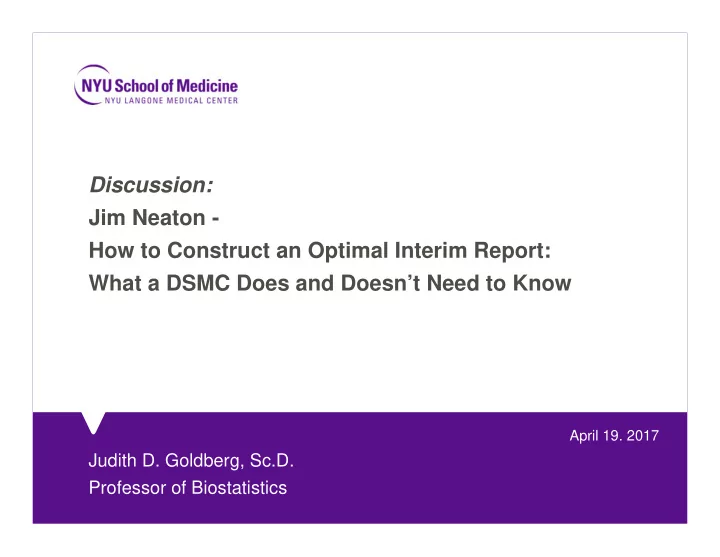

Click to edit headline for your slide here. Discussion: Jim Neaton - How to Construct an Optimal Interim Report: What a DSMC Does and Doesn’t Need to Know April 19. 2017 Judith D. Goldberg, Sc.D. Professor of Biostatistics
Personal Perspectives Click to edit headline for your slide here. View from: DSMC Study Member Statistician Industry × × Academia × × [NIH, other funded] 2
Does ‘one size fit all?’ Click to edit headline for your slide here. Trial Design • Active vs Placebo Controlled • Superiority vs Noninferiority vs Equivalence Disease [severity] Risk to Trial Participants Seriousness of Outcome of Interest Trial Duration Potential for Impact on Trial Conduct Other considerations 3
Interim Monitoring: Click to edit headline for your slide here. How Often? Of What? Safety Monitoring • Frequency of monitoring [eg, every 6 months] • Unmasked (coded) treatment group assignment • Known, unknown adverse events Efficacy Monitoring • Success / Futility • Masked / Unmasked (coded) treatment group • Frequency of monitoring · At all DSMC meetings · At planned interim analysis times; how often • Interim analysis boundaries Formal / informal 4
Example : Placebo Controlled Masked RCT Click to edit headline for your slide here. Non-life threatening Primary outcome: first recurrence by 12 months end of treatment period Accrual over 4 years, 18 months of followup Multi-center DSMC meetings 2x/year • Safety monitoring • Efficacy Monitoring 5
Example: Efficacy Monitoring Click to edit headline for your slide here. DSMC / Investigator Views DSMC • Monitor unmasked efficacy at every meeting (approximately 8 times) • Stopping boundaries at p very low • One formal planned interim analysis: O’Brien Fleming boundaries for efficacy; no futility boundaries Investigators • One formal planned interim analysis: O’Brien Fleming boundaries for efficacy and futility • No interim analyses 6
Impacts on Study Conduct Click to edit headline for your slide here. DSMC • Stated goal ‘not to stop the study’ • Needs efficacy to evaluate safety Investigators • Would not like to stop study • Efficacy would always be available to DSMC if any safety concerns at all • Concerns re impact of repeated looks - On final p-value for efficacy - Influence on behavior 7
Informal Survey Click to edit headline for your slide here. Respondents confidentiality preserved Very small convenience sample Responses • Initial response: · DSMC needs to see everything • Thoughtful responses: · Depends on trial and implications 8
Acknowledgements Click to edit headline for your slide here. Thank you to my statistical and clinical colleagues for thoughtful discussions of these issues Thank you to the speaker and panelists for a provocative discussion 9
Recommend
More recommend